Bear Journal - 2003
Welcome to our Bear Journal. We will update this page periodically with information on the bears currently in our care. The update will include cubs of the year and yearlings (cubs a year old) that are held through winter for a spring release. Note: following information will remain on this page until 2004 cubs they start arriving.
January, 2003
During 2002, we received six orphaned cubs - three from Utah and three from Idaho. Due to the small body frames on four of the cubs, we decided to winter them all through here rather than put them in dens in the mountains during December. The bears started in hibernation in dens in the enclosure during the latter part of December. As usually happens, all six began hibernation in the same 4' x 4' den. No doubt it was very warm with all those bodies and probably a bit cramped. Several of the bears came out for half an hour off and on during the winter, probably to get the kinks out and cool off a bit as we didn't have a very cold winter.
The information below will tell you a bit about each orphaned cub, when they arrived and where they came from. We do not give the bears people names - they are normally given Native American or Hawaiian names. Keep in mind that cubs are born late January into February so all the bears are the same age within 3-4 weeks of each other regardless of arrival date or weight at time of arrival.
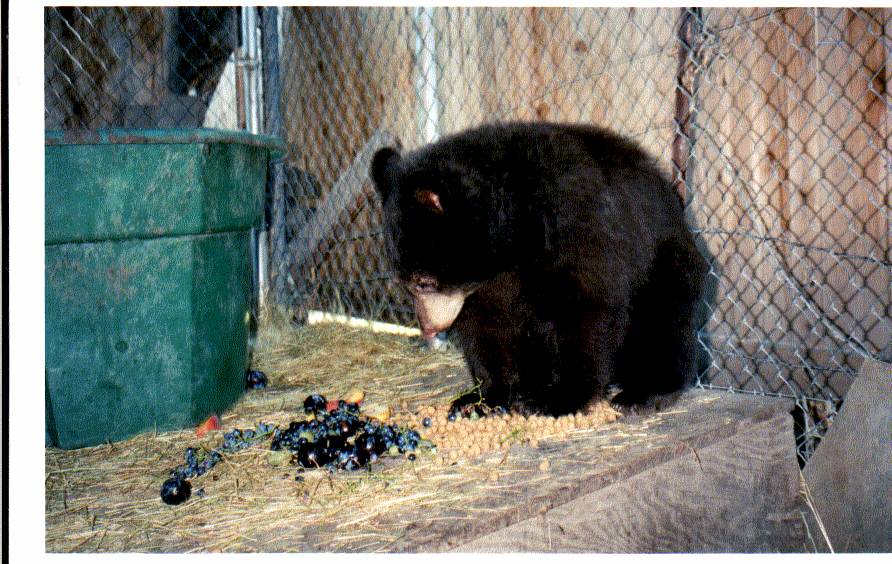
Makana - arrived 5/29/02 from Utah - female - dark brown, no white markings but a few beige hairs on chest area. Name is Hawaiian meaning "gift". Makana weighed 9 pounds on arrival and 73 pounds when last weighed 9/28/02. Makana is a very mellow bear with a wonderful personality. She is very smart, very athletic and is the leader of the group.
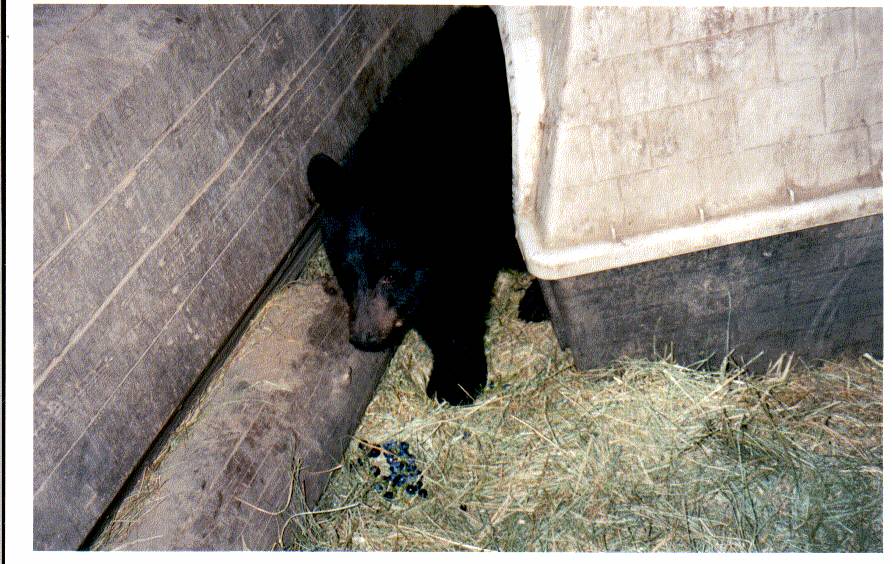
Mato - arrived 9/12/02 from Idaho - female - black with white markings on chest. Name is Dakota meaning "black bear". Mato weighed approximately 40 pounds on arrival and 63 pounds when last weighed on 10/2/02. Mato is the glamorous one of the group. Her sleek, shiny black coat stood out immediately and despite the rough play, she always looked as though she just came from the hairdresser. She is quite shy and runs for the den whenever she hears a strange sound or sees something she thinks is unusual.
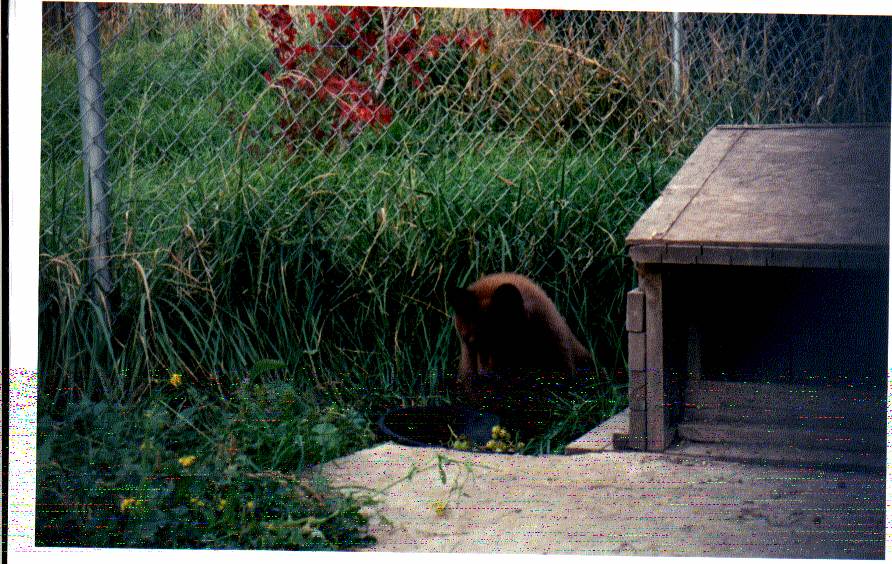
Wikopa - arrived 9/20/02 from Utah - female - medium light brown with a slight gold tinge - no white markings. Name is Dakota meaning "shy". Wikopa weighed approximately 28 pounds on arrival and 35 pounds on 10/4/02. Wikopa is the smaller of the three Utah bears and very quickly became best friends with Koa, following her everywhere. If Koa ran, Wikopa ran. If Koa went for water, Wikopa went for water.
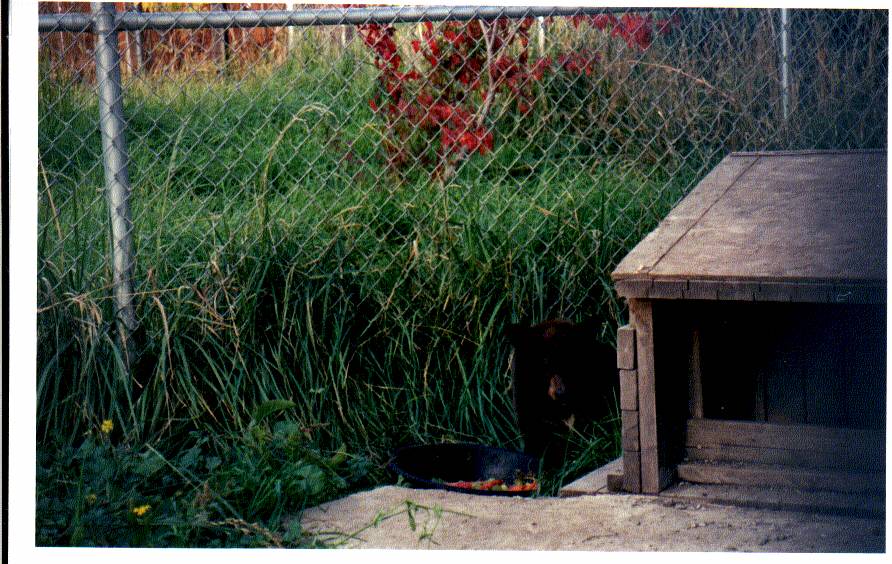
Owapi - arrived 9/23/02 from Idaho - female - chocolate brown with white markings on chest. Name is
Dakota meaning "colors". She had a lighter tinge to her body which became even more obvious by hibernation time while her head, chest, and legs remained a dark chocolate brown. Hence the reason for her name. Owapi weighed approximately 30 pounds on arrival and 38 pounds when last weighed on 10/4/02. Owapi is an outgoing bear and second in command to Makana. She likes to investigate her surroundings to see what might be new or interesting since her last inspection.
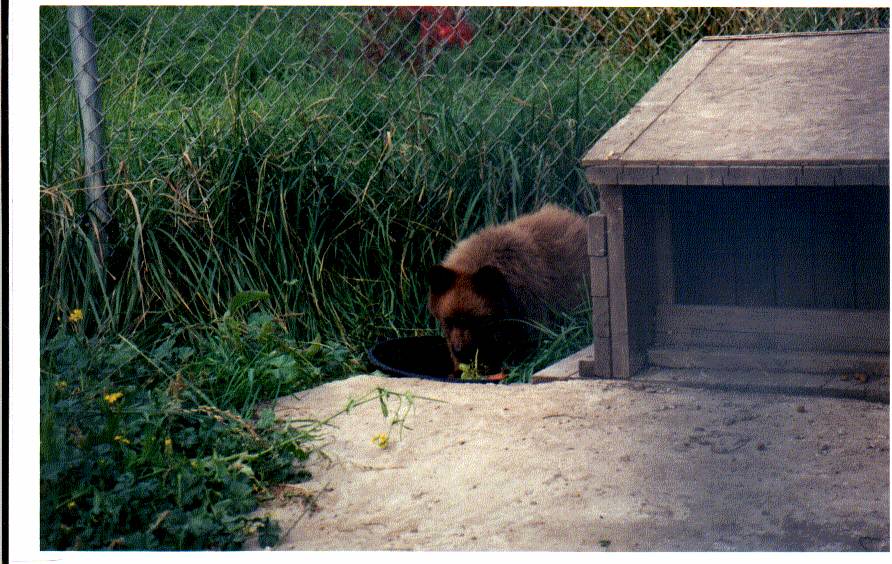
Koa - arrived 10/2/02 from Utah - female - medium light brown with slight gold tinge - no white markings. Name is Hawaiian meaning "brave or bold". Koa weighed 38 pounds on arrival and that was the only weight we got on her before hibernation. She is a bit larger than Wikopa and has accepted her position as Wikopa's best friend. If Koa is going for water or food, Wikopa will follow behind her. However, if Wikopa gets frightened for some reason and runs back to the dens, Koa will go back and get her again and again if necessary until they both make it to the food and water.
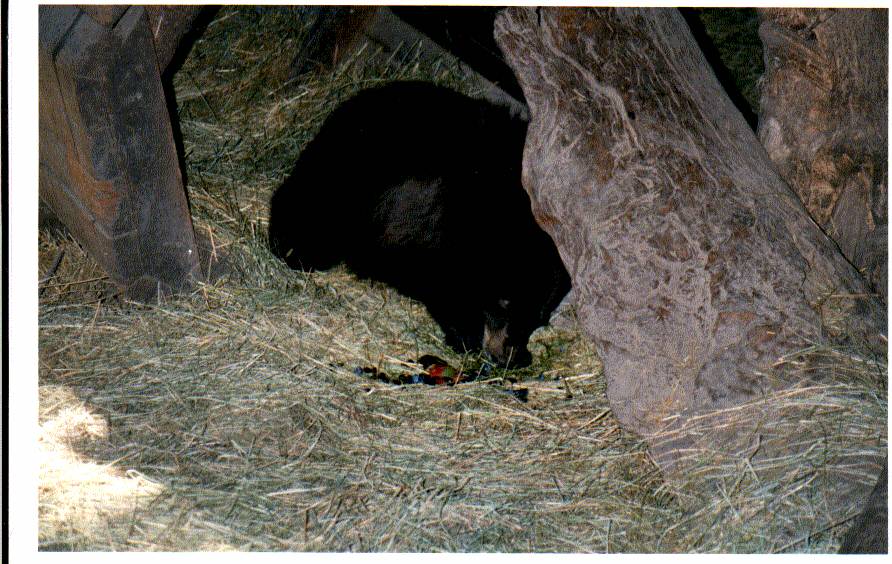
Wape - arrived 10/5/02 from Idaho - male - very dark chocolate brown with small white markings on chest. Name is Dakota meaning "lucky". She was only saved through the determined persistence of a couple who made it their duty to see she got help when help wasn't easy to get. Wape weighed about 10 pounds on arrival and approximately 16 pounds when last weighed 10/12/02.
March 17, 2003
All the bears have been out of hibernation since the first week of March. The weather kept them in the dens some of the time, but they became increasingly active with each day. Now they are out from about noon until 5pm each day. They are wrestling, chasing each other around logs and up on tree stumps. Despite the fact it's not yet that warm, they have already made it clear they wanted water in the swim tub. The minute we filled it, Makana dove in while the rest played with the stream of water coming down into the tub.
Three of the six cubs have lost the long outer hairs of their coat due to the amount of heat generated by all six bears in one den. They have retained the thick undercoat. Owapi, who had the lighter tinge to her coat is quite striking to see now. She is one who lost the longer out hairs and her undercoat is a dirty gray color while her head, neck, and legs all remain dark chocolate. Mato, whose coat was so striking looks like she forgot to comb out the tangles. As bears usually do when coming out of hibernation, they all look like many of us who are not morning people feel each morning. Within about 5 weeks, their coats will once again be thick and sleek. None of the six appear to have lost much weight during hibernation. Owapi, Wikopa, Koa, and Wape all had small body frames when they arrived and now have grown in size as we hoped. Once they begin putting on weight, they will be ready for spring release.
They are now eating about 40 pounds of dog food every couple of days, 20-30 apples a day, 12 carrots a day, a pile of acorns, vegetation, bugs, and worms they find in the enclosure. With each week they will increase the amount of food and by release time the first of June, will have built their weights up quite a bit. We will update you on that information when the time comes.
Update: 2002 Bears - Released June 2003
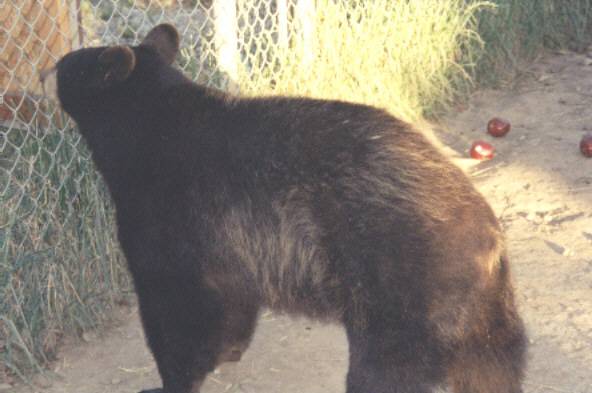 By the time the release date arrived, all six bears were ready to take charge of their lives....and so was Sally! This group of bears did more damage to the enclosure than the last two groups put together. They started working on the 14' x 27' wood roof area covering the dens in fall 2002. By May they had ripped off the entire roof except a small 4' area. They dug up the dirt covering the dens, ate most of the vegetation, and uncovered the trees buried in cement. Previously we strengthened the chain link roof with a strip of chain link across each seam. Then we wove metal rods between the two chain link panels to secure them in place. These wonderfully creative bears amused themselves by lying on their backs on the wood roof area while working free some metal rods. With a casual show of strength, they bent each rod just enough so it would not slip back in place. We had to replace about six rods over the roof area.
By the time the release date arrived, all six bears were ready to take charge of their lives....and so was Sally! This group of bears did more damage to the enclosure than the last two groups put together. They started working on the 14' x 27' wood roof area covering the dens in fall 2002. By May they had ripped off the entire roof except a small 4' area. They dug up the dirt covering the dens, ate most of the vegetation, and uncovered the trees buried in cement. Previously we strengthened the chain link roof with a strip of chain link across each seam. Then we wove metal rods between the two chain link panels to secure them in place. These wonderfully creative bears amused themselves by lying on their backs on the wood roof area while working free some metal rods. With a casual show of strength, they bent each rod just enough so it would not slip back in place. We had to replace about six rods over the roof area.
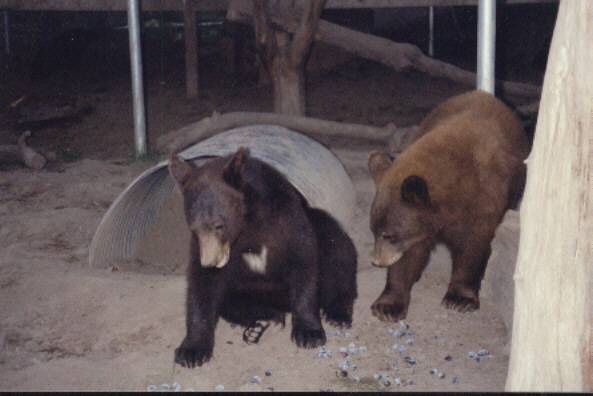 Nor did it take them very long to figure out how best to deal with the swim tub. In their minds they probably improved it, but in our minds they destroyed it. One or two bears would either get inside the tub and pull the edge inward or stand outside push it inward. The heavy duty frame with gallons and gallons of water pressure worked against their efforts. With amazing strength, they easily accomplished their goal, allowing the water to flow out the tub, down the frame and the logs below, creating a natural waterfall. Since we had water flowing in the swim tub continuously, it was a never-ending flow of water that began to flood the enclosure. Now they had a terrific mud bath to play in too. Such delightfully happy bears - such miserable, unhappy people! It took four of us, after draining the tub, to bend it back in place. Like the optimistic people we are, we thought the water pressure would hold it in place and the bears would leave it alone. Two days later, a repeat of the same event took place. After struggling with it no less than five times, VP Tom Robb finally nailed the swim tub edges to a frame that did not allow the bears to create their waterfall effect. Unfortunately, the mud bath remained. With all the bending, the bears cracked the tub and the water leaked continuously out the cracks. Sealing it was impossible while the bears were in the enclosure. Besides their curiosity about what we were doing, they would have smelled the sealant. Almost immediately, they would have tried to reach it and pull it off, probably licking it in the process - not a healthy thing to do with most sealant materials. They still had a very messy area to slide in, roll in, and wrestle in with each other whiled covered in mud. To their sheer joy, they also shared the fun with Sally when she came in each day to feed and pick up bear scat. Spraying mud baths as bears tore through the area at full speed caught her more than once right in the face. We had to replace the huge swim tub and the frame. For the second time, Tom Robb replaced all the plumbing that went to the tub. This is one group of bears that definitely taught us a lot. We won't forget them any time soon!
Nor did it take them very long to figure out how best to deal with the swim tub. In their minds they probably improved it, but in our minds they destroyed it. One or two bears would either get inside the tub and pull the edge inward or stand outside push it inward. The heavy duty frame with gallons and gallons of water pressure worked against their efforts. With amazing strength, they easily accomplished their goal, allowing the water to flow out the tub, down the frame and the logs below, creating a natural waterfall. Since we had water flowing in the swim tub continuously, it was a never-ending flow of water that began to flood the enclosure. Now they had a terrific mud bath to play in too. Such delightfully happy bears - such miserable, unhappy people! It took four of us, after draining the tub, to bend it back in place. Like the optimistic people we are, we thought the water pressure would hold it in place and the bears would leave it alone. Two days later, a repeat of the same event took place. After struggling with it no less than five times, VP Tom Robb finally nailed the swim tub edges to a frame that did not allow the bears to create their waterfall effect. Unfortunately, the mud bath remained. With all the bending, the bears cracked the tub and the water leaked continuously out the cracks. Sealing it was impossible while the bears were in the enclosure. Besides their curiosity about what we were doing, they would have smelled the sealant. Almost immediately, they would have tried to reach it and pull it off, probably licking it in the process - not a healthy thing to do with most sealant materials. They still had a very messy area to slide in, roll in, and wrestle in with each other whiled covered in mud. To their sheer joy, they also shared the fun with Sally when she came in each day to feed and pick up bear scat. Spraying mud baths as bears tore through the area at full speed caught her more than once right in the face. We had to replace the huge swim tub and the frame. For the second time, Tom Robb replaced all the plumbing that went to the tub. This is one group of bears that definitely taught us a lot. We won't forget them any time soon!
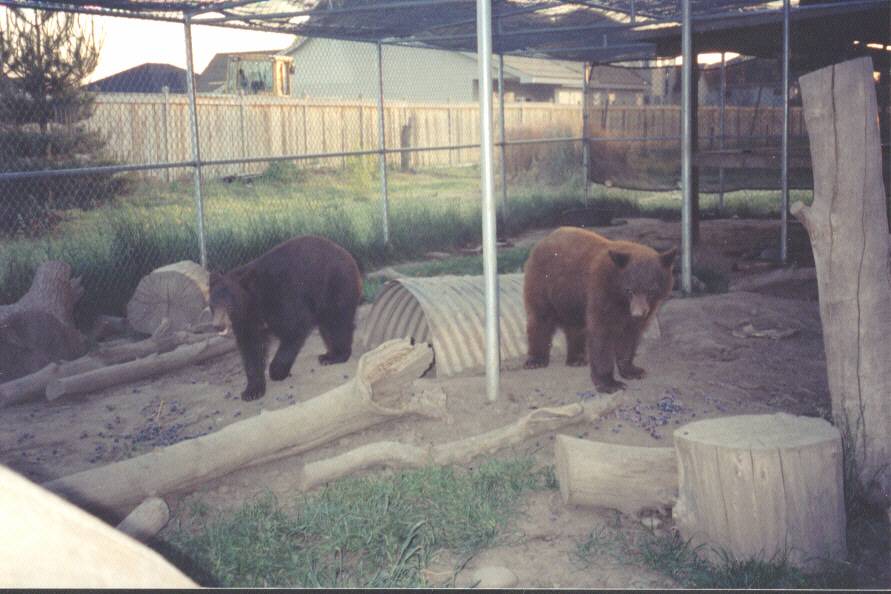 With both excitement for them and a bit of sadness to see them leave, we made arrangements for their release in June. Idaho Fish & Game extended spring hunting season so we held the bears until the second week of June. On June 8 we tranquilized all three Idaho bears. We got their weights and measurements, did a health check, gave them the last Ivermectin shots for parasites, fitted the radio collars and put in the identifying ear tags. Our final task was to give them the bear hugs we couldn't do at any other time. Wape appeared to have a slight wobble in his walk. It had not been visible before, but started showing up after he came out of hibernation. Dr. Murphy took x-rays and found he had a break in his pelvis that was completely healed. The fact he came in late in the year, was very shy, remained in the den most of the time before starting hibernation was probably the best medicine. That allowed the break to heal. Looking back, the injury was probably why he was up the tree for so long and his mother abandoned him. We drove Wape, his buddy Mato, and Owapi to the release site about three hours away.
With both excitement for them and a bit of sadness to see them leave, we made arrangements for their release in June. Idaho Fish & Game extended spring hunting season so we held the bears until the second week of June. On June 8 we tranquilized all three Idaho bears. We got their weights and measurements, did a health check, gave them the last Ivermectin shots for parasites, fitted the radio collars and put in the identifying ear tags. Our final task was to give them the bear hugs we couldn't do at any other time. Wape appeared to have a slight wobble in his walk. It had not been visible before, but started showing up after he came out of hibernation. Dr. Murphy took x-rays and found he had a break in his pelvis that was completely healed. The fact he came in late in the year, was very shy, remained in the den most of the time before starting hibernation was probably the best medicine. That allowed the break to heal. Looking back, the injury was probably why he was up the tree for so long and his mother abandoned him. We drove Wape, his buddy Mato, and Owapi to the release site about three hours away.
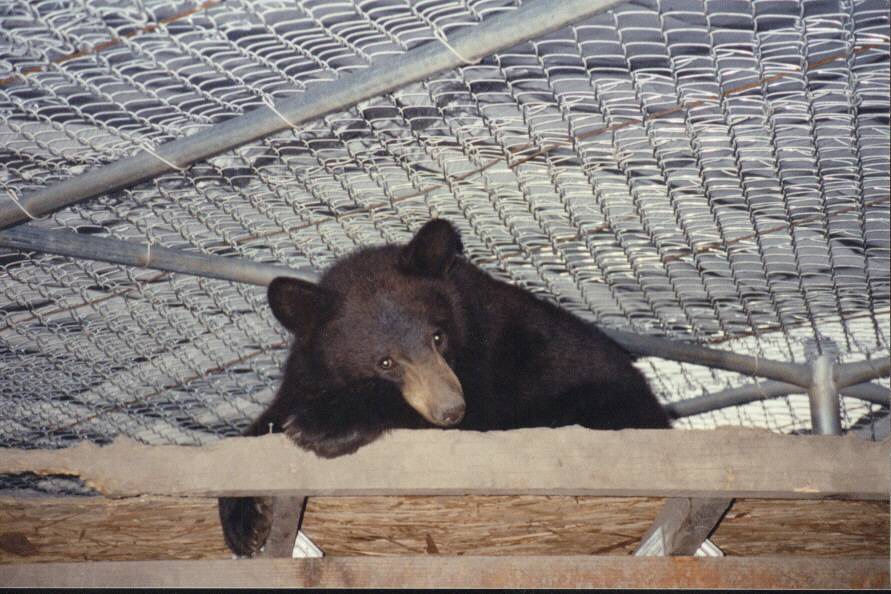 Mato - As we opened the carriers, Mato made one big jump and tore off into the woods at full speed. By this time she weighed 138 pounds and we had about twenty seconds to watch this beautiful sleek and silky looking black bear before she disappeared out of sight. About three weeks later, we began tracking the cubs using the signals from their radio collars. We were never able to locate Mato, which means she moved out of range or the radio collar stopped working.
Mato - As we opened the carriers, Mato made one big jump and tore off into the woods at full speed. By this time she weighed 138 pounds and we had about twenty seconds to watch this beautiful sleek and silky looking black bear before she disappeared out of sight. About three weeks later, we began tracking the cubs using the signals from their radio collars. We were never able to locate Mato, which means she moved out of range or the radio collar stopped working.
Owapi - Second out of the carriers and weighing 110 pounds, immediately went to the nearest tree. In the blink of an eye she was about 30 feet high, resting her rump on a branch while looking around at this new world. She remained there for almost half an hour before coming down and walking into the woods in the opposite direction from Mato. We later tracked Owapi until the radio collar dropped off and she remained in the same release area.
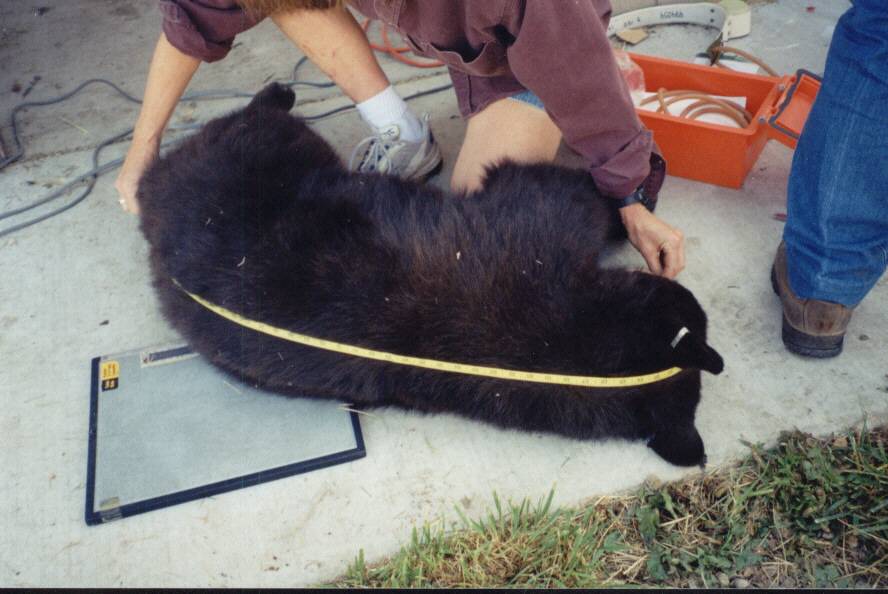 Wape - Also weighing 101 pounds, Wape came out of the carrier a bit cautiously at first, slowly jumping down from the carrier to the ground. With his unusual stride, he went to the same tree where Owapi still sat and began slowly climbing it. He kept looking up at Owapi and going higher, then backing down. He probably realized she had the only sturdy branch for support. That was a long way up just to come back down. About seven feet up the tree, Wape shinnied to the ground and walked off into the woods in the same direction Owapi would later take. We worried about his unusual wobble as he walked and how it would affect him in the real world. However, this very determined bear made it clear it was not going to hinder him. Our release site is about three hours away by car. In mid-July, Wape showed up just several miles away from us. We had a couple of reports of a small cub with a radio collar. John Beecham went out with the tracking antennae, found him a couple of times, but was never able to see him visually. Volunteer Tracy Mott also tracked him until the collar dropped off. By then it was late September & he had moved into the nearby mountains.
Wape - Also weighing 101 pounds, Wape came out of the carrier a bit cautiously at first, slowly jumping down from the carrier to the ground. With his unusual stride, he went to the same tree where Owapi still sat and began slowly climbing it. He kept looking up at Owapi and going higher, then backing down. He probably realized she had the only sturdy branch for support. That was a long way up just to come back down. About seven feet up the tree, Wape shinnied to the ground and walked off into the woods in the same direction Owapi would later take. We worried about his unusual wobble as he walked and how it would affect him in the real world. However, this very determined bear made it clear it was not going to hinder him. Our release site is about three hours away by car. In mid-July, Wape showed up just several miles away from us. We had a couple of reports of a small cub with a radio collar. John Beecham went out with the tracking antennae, found him a couple of times, but was never able to see him visually. Volunteer Tracy Mott also tracked him until the collar dropped off. By then it was late September & he had moved into the nearby mountains.
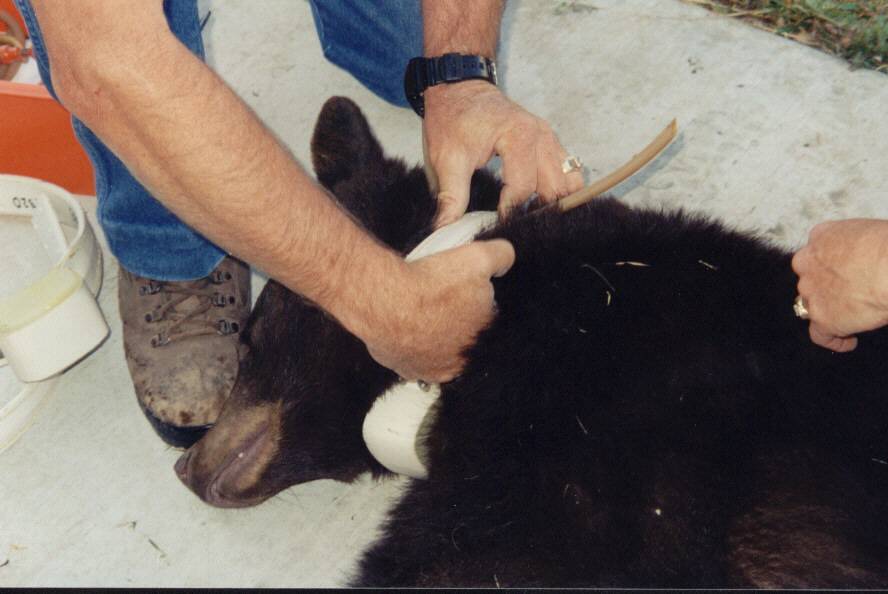 The three Utah cubs, Makana weighing 119 pounds, Wikopa weighing 120 pounds, & Koa weighing 127 pounds, left for Utah early June 9. Utah officials met us half way where we tranquilized the cubs, fitted the radio collars, and put in identifying ear tags. Utah took the cubs the rest of their long journey to the release area. By the time they arrived at the 10,000 acre release site, it was close to 11pm. After opening the carrier doors, Makana, always the leader of the group, waited nearby while Wikopa and Koa came out of the carriers behind her. Then they all wandered off in the darkness of the woods.
The three Utah cubs, Makana weighing 119 pounds, Wikopa weighing 120 pounds, & Koa weighing 127 pounds, left for Utah early June 9. Utah officials met us half way where we tranquilized the cubs, fitted the radio collars, and put in identifying ear tags. Utah took the cubs the rest of their long journey to the release area. By the time they arrived at the 10,000 acre release site, it was close to 11pm. After opening the carrier doors, Makana, always the leader of the group, waited nearby while Wikopa and Koa came out of the carriers behind her. Then they all wandered off in the darkness of the woods.
|

